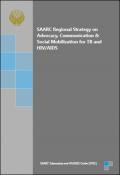Publications - Released in 2012
The SAARC Regional Strategy for TB and HIV Co-infection recognizes that TB and HIV/AIDS are two major public health problems in the SAARC Region. Out of the eight countries, four countries- namely Afghanistan, Bangladesh, India and Pakistan are among 22 high TB burden countries, globally. TB is the most common opportunistic infection and the cause of death for those infected with HIV/AIDS. TB adds to the burden of illness of people infected with HIV while HIV accelerates the progress of TB infection to active TB disease, and has implications for the public health.
In this region, the HIV/AIDS prevalence in general population is still low but its prevalence
among high risk groups has increased during the last decade which is a cause of concern.
The role of ACSM is crucial in achieving a world free of TB and HIV/AIDS. The aim of Advocacy, Communication and Social Mobilization (ACSM) is to support National TB and HIV/AIDS Control Programmes of the SAARC Region to combat stigma and discrimination, improve case detection and treatment adherence, empower people affected by TB and HIV/AIDS and to mobilize political commitment and resources for TB and HIV/AIDS. ACSM strategy incorporates various types of communication programming, including mass media, interpersonal communication, community mobilization and advocacy.
Downloads
Organizations
- South Asian Association for Regional Cooperation (SAARC)






